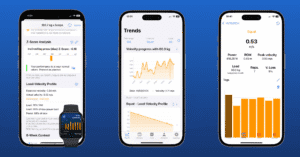Athlete Management Systems (AMS) have revolutionized how coaches, trainers, and sports organizations monitor and optimize athletic performance through comprehensive data collection and analysis. These systems provide invaluable insights when integrated with modern training methodologies like Velocity-Based Training (VBT). Spleeft App represents an innovative solution in this space, offering coaches the ability to manage multiple athlete profiles while implementing VBT principles. Recent partnerships between VBT technology providers and AMS platforms highlight the growing convergence of these systems to create more effective training ecosystems that enhance athlete development, prevent injuries, and improve overall performance outcomes.
DOWNLOAD SPLEEFT APP NOW FOR iOS, ANDROID AND APPLE WATCH!
Athlete Management Systems & Velocity Based Training
Understanding Athlete Management Systems
Athlete Management Systems serve as centralized digital platforms that collect, organize, and analyze athlete data to inform training decisions and optimize performance outcomes. These comprehensive systems have evolved from simple tracking tools to sophisticated platforms that integrate multiple data sources to provide holistic views of athlete development.

Core Functions and Purpose
The primary purpose of an Athlete Management System is to establish a framework for tracking and analyzing performance metrics for athletes, teams, and squads. Since 2013, the Australian Institute of Sport’s AMS has been providing significant value to the Australian sporting network by accommodating various National Sporting Organizations (NSOs) and the National Institute Network (NIN) on a single combined system[1]. This unified approach allows for stronger partnerships between disciplines across organizations while providing cost-effective solutions for performance management.
AMS platforms capture data from diverse sources, including athlete-entered questionnaires, automated integration of wellbeing and monitoring tools, and purpose-built custom applications[1]. These data sources enable further analysis that provides athletes, coaches, and support staff with alerts, reports, and visualizations to better facilitate communication and decision-making processes. The comprehensive nature of these systems ensures that performance-related data for categorized athletes is available in a single source, accessible to authorized personnel regardless of geographic location.
Impact on Athletic Development
The implementation of effective AMS Athlete Management Systems has demonstrated measurable impacts on athletic development. The Australian Institute of Sport reports that their AMS has recorded over 17 million observations, including training sessions and injury treatments, on more than 32,000 athletes across 45 sporting organizations[1]. This extensive data collection has enabled sports organizations to reduce injury risk and increase awareness and education among data users.
By providing a systematic approach to athlete monitoring, AMS platforms increase athlete availability for training and competition through the reduction of injury and illness while also enhancing understanding of adaptation to training and travel[1]. This comprehensive approach ensures that coaches and support staff can make informed decisions about athlete workloads, recovery strategies, and training progressions based on objective data rather than subjective assessments.
Velocity-Based Training: Principles and Applications
Velocity-Based Training represents a paradigm shift in strength and conditioning practices, moving beyond traditional load-based approaches to incorporate movement velocity as a key training variable. This methodology enables more precise training prescriptions and adaptations tailored to individual athlete needs.
Fundamentals of VBT Methodology
Velocity-Based Training is a strength training methodology where the velocity of movement (velocity) is tracked during an exercise[2]. Rather than relying solely on weight or repetitions, VBT focuses on maintaining optimal movement velocity to enhance performance outcomes. This approach is founded on the principle that performance improvements occur when athletes train at specific movement velocities that optimize desired adaptations.
The core metrics in VBT include mean velocity, which measures the average velocity across a movement, and peak velocity, which indicates the highest velocity achieved during a lift[2]. By monitoring these metrics, coaches can ensure athletes are consistently training within their optimal power output ranges. This real-time feedback allows for immediate adjustments to training loads based on actual performance rather than predetermined programs that may not account for daily fluctuations in readiness.
Benefits for Athletic Performance
The implementation of VBT provides several significant benefits for athletic development. Research supports that athletes training with velocity monitoring experience enhanced neuromuscular adaptations, which improve explosive strength crucial for sports requiring high-velocity movements[2]. This approach leads to improved strength gains by emphasizing velocity alongside resistance, creating more functional adaptations that transfer directly to sport performance.
VBT also excels in fatigue management through real-time feedback that allows for immediate adjustments to reduce injury risk[2]. By monitoring velocity trends during training sessions, coaches can ensure athletes do not push beyond their physiological limits on days when recovery is incomplete. This autoregulation prevents overtraining while maintaining optimal training stimuli, leading to more sustainable progress and reduced injury rates.
Perhaps most importantly, VBT enables highly personalized programming tailored to each athlete’s readiness and recovery status[2]. By building load-velocity profiles for individual athletes, coaches can understand estimated one-rep maximums and prescribe loads or target velocities based on an athlete’s current capabilities rather than historical performance. This individualized approach optimizes training adaptations while accommodating the unique needs and constraints of each athlete.
Integration of AMS and VBT Technologies

The convergence of Athlete Data Management System and Velocity-Based Training represents a significant advancement in sports performance technology, creating comprehensive ecosystems that enhance the training process from data collection to program implementation.
Emerging Partnerships and Solutions
Recent industry developments highlight the growing integration between AMS platforms and VBT technologies. This collaboration bridges the gap between data-driven insights and athletic performance optimization, providing streamlined tools for athlete monitoring and training strategy development.
This partnership exemplifies how VBT data can be incorporated into broader athlete health management system frameworks to provide more comprehensive approaches to performance enhancement. By combining real-time velocity metrics with athlete management capabilities, delivers tools specifically designed for strength coaches, NCAA programs, and NSCA professionals. This integration allows for more seamless data flow between training sessions and long-term athlete development planning.
Data-Driven Decision Making
The integration of AMS and VBT creates powerful opportunities for data-driven decision making in athletic management system. When velocity data is incorporated into comprehensive athlete management systems, coaches can contextualize performance metrics within broader patterns of training loads, recovery status, and injury risk factors. This holistic view enables more informed decisions about training progressions, competition readiness, and long-term development strategies.
By combining real-time velocity feedback with historical performance data, these integrated systems allow coaches to identify trends that might not be apparent from either dataset in isolation. For example, velocity decreases might correlate with certain training phases, travel schedules, or academic stressors identified in the AMS data. These insights enable proactive adjustments to training programs that maintain performance while preventing overtraining or injury.
Spleeft App: VBT Technology for Coaches
Spleeft App represents an innovative solution in the VBT space, providing accessible velocity-based training tools with specific features designed for coaches managing multiple athletes.
If as a coach you are looking for the best athlete management systems in Spleeft Coach you will find what you are looking for.
Compatible with all VBT devices on the market such as Vitruve, ADR Encoder and more.
Spleeft Coach will allow you to have access to Advanced VBT analytics, create multiple athlete profiles and import CSV data from any VBT Device thanks to our AI. [3].
Key Features and Functionality
Spleeft delivers comprehensive VBT functionality through a user-friendly mobile and desktop application ecosystem. The app tracks the velocity of each repetition in real-time, allowing coaches to adjust load or volume based on immediate performance data[4]. If velocity drops below target thresholds or decreases too quickly within a set, coaches can make informed decisions about reducing load or ending sets early to maintain specific training goals, whether focused on maximal strength, power, or endurance.
Beyond basic velocity tracking, Spleeft monitors velocity loss within sets by comparing the fastest repetition to the slowest[4]. This metric serves as a critical indicator of neuromuscular fatigue, helping coaches ensure effective training stimulus while avoiding excessive fatigue that might compromise subsequent training sessions or increase injury risk. After completing sets or sessions, the app generates detailed graphs showing average velocity, best repetitions, and velocity loss patterns that enable thorough performance analysis.
For data management, Spleeft provides robust export capabilities, allowing coaches to generate detailed reports in Excel format with just a few clicks[4]. This feature facilitates comprehensive tracking of progress over time, comparison between different sessions, and sharing of insights with athletes. The ability to export and analyze data enhances the coach’s capacity to make evidence-based decisions about program design and implementation.
Multi-Athlete Management Capabilities
Spleeft offers particular value for coaches managing multiple athletes through its streamlined organizational features. The Mac version of the application provides an optimized interface for viewing and comparing data across different athletes, making it easier to track team-wide trends while maintaining individualized training approaches[4]. Coaches can efficiently switch between individual athlete profiles, review session histories, and develop comprehensive perspectives on overall progress for each team member.
The application utilizes a tagging system to help coaches efficiently manage multiple athletes and exercise variations[4]. These tags allow for filtering data by individual athletes, exercise types, or specific variations such as unilateral movements. This organizational structure simplifies the management of complex training programs involving numerous athletes with varying needs and goals.
For coaches tracking multiple clients in a single training session, Spleeft allows simultaneous review and export of their data, saving valuable time while ensuring each athlete receives precise, real-time feedback on their performance[4]. This multi-athlete capability transforms the app from a simple velocity measurement tool into a comprehensive coaching platform that enhances decision-making capabilities through accurate, easy-to-read data presented on larger screens.
Data Visualization and Analysis Tools
Effective data visualization and analysis represent critical components of both AMS platforms and VBT applications, enabling coaches to convert raw data into actionable insights that drive performance improvements.
Performance Metrics and Reporting
Both AMS platforms and applications like Spleeft provide sophisticated reporting capabilities that transform raw data into meaningful visualizations. The Australian Institute of Sport’s AMS converts millions of observations into alerts, reports, and visualizations that facilitate communication and decision-making among athletes, coaches, and support staff[1]. These reporting features help identify patterns that might not be apparent from examining isolated data points.
Spleeft generates detailed graphs showing critical performance metrics like average velocity, peak performance (fastest repetition), and velocity loss patterns[4]. These visualizations allow coaches to analyze training sessions comprehensively, identifying strengths, weaknesses, and areas requiring adjustment. The app’s focus on visualizing trends over time is enhanced on larger screens like Macs, where patterns become more apparent and easier to interpret[4].
Long-Term Trend Analysis
One of the most valuable aspects of integrating VBT data into athlete management frameworks is the ability to conduct long-term trend analysis. Spleeft on Mac provides enhanced capabilities for diving deep into long-term trends and performance metrics, making it easier to adapt training programs based on solid data[4]. Coaches can track how metrics like best-rep velocity change with specific loads over time, enabling them to adjust programs to optimize strength and power development based on objective performance data.
The ability to visualize load-velocity profiles or velocity loss patterns during sets on larger screens enhances coaches’ capacity to identify subtle changes in performance that might indicate improvements or areas requiring attention[4]. This comprehensive view of performance evolution helps coaches develop more effective periodization strategies, targeting specific adaptations based on observed patterns rather than predetermined program structures.
Practical Applications for Coaches and Athletes
The integration of AMS platforms and VBT technologies creates numerous practical applications that enhance training efficiency and effectiveness for both coaches and athletes.
Optimizing Training Prescription
The combination of AMS data and VBT metrics enables highly optimized training prescription based on individual athlete characteristics and readiness. Velocity-based training tools like Spleeft allow coaches to implement auto-regulation by modifying weights if velocity slows below target ranges[2]. This approach prevents overtraining while ensuring optimal performance stimulus, leading to more consistent progress with reduced injury risk.
Coaches using integrated systems can develop load-velocity profiles for individual athletes, which serve as powerful tools for prescribing training loads[2][4]. These profiles enable coaches to understand estimated one-rep maximums without requiring frequent maximal testing, reducing fatigue while maintaining accurate training prescriptions. Advanced platforms can even suggest appropriate loads or target velocities based on individual profiles, streamlining the coaching process while maintaining personalization.
Fatigue Monitoring and Recovery Management
Perhaps the most immediate practical benefit of integrated AMS and VBT systems is enhanced fatigue monitoring and recovery management. Velocity loss metrics provided by applications like Spleeft serve as sensitive indicators of neuromuscular fatigue, allowing coaches to make real-time adjustments to training sessions[4]. When velocity decreases more rapidly than expected, coaches can reduce volume or intensity to prevent excessive fatigue that might compromise subsequent training sessions.
The Australian Institute of Sport’s AMS specifically highlights increased athlete availability for training and competition through reduced injury and illness as a key benefit[1]. By combining daily readiness assessments from AMS platforms with objective performance metrics from VBT tools, coaches can implement truly individualized approaches to training that account for each athlete’s current physiological state rather than following rigid program structures that ignore individual variations in recovery capacity.
Conclusion
The integration of Athlete Management Systems with Velocity-Based Training technologies represents a significant advancement in sports performance monitoring and optimization. These complementary systems create comprehensive frameworks for athletic development that combine long-term tracking capabilities with immediate performance feedback, enabling more informed coaching decisions and individualized training approaches.
AMS platforms provide the infrastructure for centralized data collection and analysis, establishing shared frameworks that capture performance-related information for entire teams or organizations. When combined with the real-time velocity metrics provided by VBT applications like Spleeft, these systems enable coaches to contextualize immediate performance within broader patterns of development, recovery, and adaptation. This integration transforms data collection from a passive recording process into an active tool for performance enhancement.
As demonstrated by recent partnerships between VBT technology providers and AMS platforms, the trend toward greater integration is likely to continue, creating even more comprehensive ecosystems for athletic development. For coaches seeking to implement evidence-based practices in their programs, solutions like Spleeft App offer accessible entry points into this integrated approach, providing multi-athlete management capabilities alongside sophisticated VBT functionality. By embracing these technological advances, coaches can develop training programs that are both more scientifically sound and more responsive to individual athlete needs, ultimately leading to enhanced performance outcomes and reduced injury risk.
References
- Australian Institute of Sport. Athlete Management System (AMS). Australian Institute of Sport.
- Perch. The science behind velocity-based training. Perch Blog.
- Spleeft App. Meet our new athlete management system for VBT. Spleeft.
- Spleeft App. Frequently asked questions (FAQs). Spleeft.
Iván de Lucas Rogero
MSC Physical Performance & CEO SpleeftApp
Dedicated to improving athletic performance and cycling training, combining science and technology to drive results.




